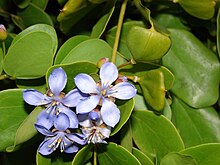| Guaiacum | |
|---|---|

| |
| Guaiacum officinale | |
| Scientific classification | |
| Kingdom: | Plantae |
| Clade: | Tracheophytes |
| Clade: | Angiosperms |
| Clade: | Eudicots |
| Clade: | Rosids |
| Order: | Zygophyllales |
| Family: | Zygophyllaceae |
| Subfamily: | Larreoideae |
| Genus: | Guaiacum L.[1] |
| Type species | |
| Guaiacum sanctum[2] L.
| |
| Species | |
|
Guaiacum angustifolium | |
Guaiacum (/ˈɡwaɪ.ə.kəm/[3][4]), sometimes spelled Guajacum, is a genus of flowering plants in the caltrop family Zygophyllaceae. It contains five species of slow-growing shrubs and trees, reaching a height of approximately 20 m (66 ft) but usually less than half of that. All are native to subtropical and tropical regions of the Americas and are commonly known as lignum-vitae, guayacán (Spanish), or gaïac (French).[5] The genus name originated in Taíno, the language spoken by the native Taínos of the Bahamas; it was adopted into English in 1533, the first word in that language of American origin.[6]
Members of the genus have a variety of uses, including as lumber, for medicinal purposes, and as ornamentals. The trade of all species of Guaiacum is controlled under CITES Appendix II.[7]
Guaiacum officinale is the national flower of Jamaica,[8] while Guaiacum sanctum is the national tree of the Bahamas.[9]
- ^ "Genus: Guaiacum L". Germplasm Resources Information Network. United States Department of Agriculture. 2008-05-20. Archived from the original on 2011-06-06. Retrieved 2009-09-25.
- ^ "Guaiacum L". TROPICOS. Missouri Botanical Gardens. Retrieved 2009-12-06.
- ^ OED 2nd edition, 1989.
- ^ Entry "guaiacum" in Merriam-Webster Online Dictionary, retrieved 2013-04-30.
- ^ Grandtner, Miroslav M. (2005). Elsevier's Dictionary of Trees: With Names in Latin, English, French, Spanish and Other Languages. Vol. 1. Elsevier. pp. 389–391. ISBN 978-0-444-51784-5.
- ^ Bailey, Richard W (2004). "Part I - American English: its origins and history". In Edward Finegan; John R. Rickford (eds.). Language in the USA: Themes for the Twenty-first Century. Cambridge University Press. p. 3. ISBN 978-0-521-77747-6.
- ^ Gordon, J. E.; González, M. A.; Vázquez Hernández, J.; Ortega Lavariega, R.; Reyes-García, A. (2005). "Guaiacum coulteri an over-logged dry forest tree of Oaxaca, Mexico". Oryx. 39 (1). Fauna & Flora International: 82–85. doi:10.1017/s0030605305000141.
- ^ "National Symbols". Emancipation & Independence. Jamaica Information Service. Archived from the original on 2011-10-28. Retrieved 2009-12-06.
- ^ "National Symbols of the Bahamas". Bahamas Facts and Figures. TheBahamasGuide. Archived from the original on 2009-12-21. Retrieved 2009-12-06.